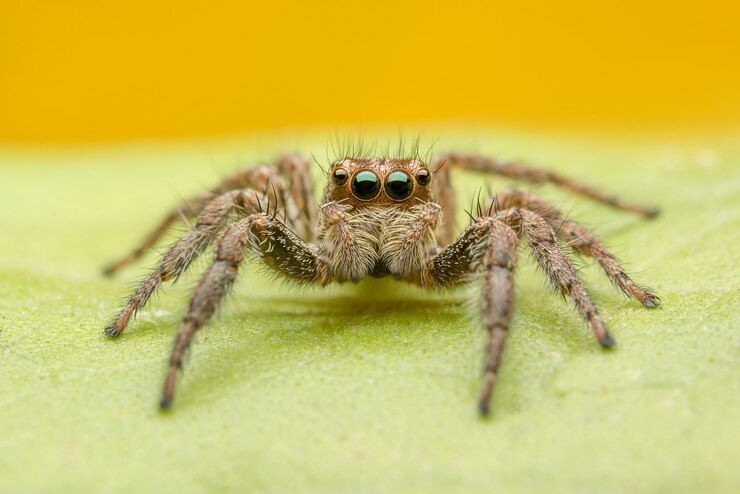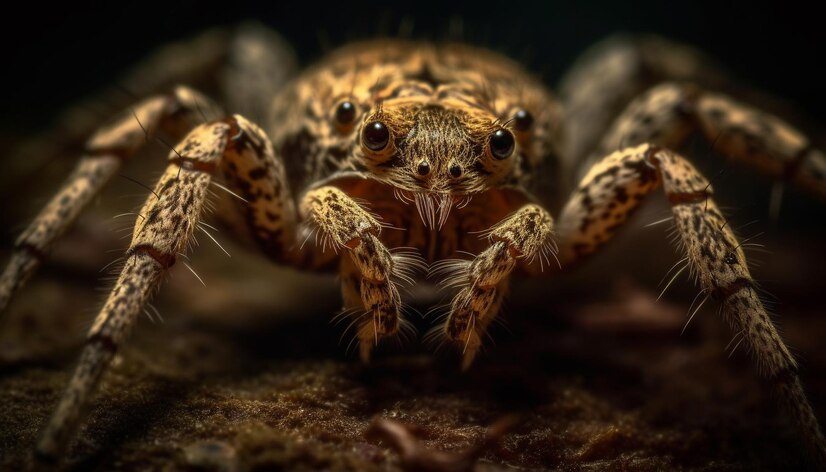Jumping spiders are fascinating creatures known for their impressive vision, agility, and energetic behavior. But how long do these tiny hunters actually live? The lifespan of a jumping spider can vary depending on several factors, including its species, environment, diet, and whether it’s in the wild or captivity. This article explores the average lifespan of jumping spiders, factors that affect their longevity, and the unique characteristics that make them one of the most captivating spider species.
Jumping Spider Species Overview

Jumping spiders belong to the family Salticidae, which encompasses over 6,000 species worldwide. They can be found in a variety of environments, from forests to grasslands, deserts, and even urban settings. While their appearance and behavior may vary slightly between species, most jumping spiders share common traits, including exceptional vision, a compact body, and a preference for actively hunting prey rather than spinning webs.
Some of the most commonly known jumping spider species include the Bold Jumping Spider (Phidippus audax), Zebra Jumping Spider (Salticus scenicus), and Regal Jumping Spider (Phidippus regius). Though they differ slightly in size and color, their lifespans follow similar patterns.
Jumping Spider as a Pet

Owning a jumping spider as a pet can be a fascinating and rewarding experience for both beginner and seasoned exotic pet owners. Jumping spiders are known for their curiosity, agility, and surprisingly interactive behavior, making them a popular choice for people looking for a low-maintenance, engaging pet. Their compact size and relatively simple habitat requirements make them easy to care for, as they only need a small, well-ventilated enclosure, a few hiding spots, and access to live prey like fruit flies or small crickets. Unlike many other spider species, jumping spiders are visually oriented and seem to “observe” their surroundings, often appearing to interact with their owners by turning their heads and tracking movement with their large, forward-facing eyes
How long do jumping spiders live in the wild typically depends on factors like predators and environmental conditions, but on average, they can live for 6 months to 1 year. In captivity, however, jumping spiders may live up to 2 years due to a controlled environment with consistent food and fewer threats.
Typical Lifespan of a Jumping Spider
So, how long do jumping spiders live? On average, the lifespan of a jumping spider ranges from 6 months to 2 years. This variation depends largely on factors like the species, environmental conditions, and the availability of food. In general:
- Male jumping spiders tend to live shorter lives, usually around 6 to 12 months. Their focus on finding mates during the breeding season can shorten their lifespans due to increased risks of predation and energy depletion.
- Female jumping spiders often live longer than their male counterparts, with an average lifespan of up to 2 years, particularly if they survive the egg-laying process and continue to care for their young.
Factors That Affect Jumping Spiders’ Lifespan
Several factors can influence how long do jumping spiders live:
- Environmental Conditions: Temperature, humidity, and the availability of food play a critical role in a jumping spider’s survival. Spiders living in more favorable climates and environments with ample food sources tend to live longer.
- Predators: how long do jumping spiders live Jumping spiders are vulnerable to natural predators such as birds, lizards, and larger insects. Predation can significantly reduce their lifespan in the wild.
- Diet: A consistent diet of small insects and other prey is crucial for jumping spiders to maintain their energy and health. Poor nutrition can shorten their lives, while a healthy diet supports longer life.
- Captivity vs. Wild: Jumping spiders in captivity may live longer due to the controlled environment, lack of predators, and steady food supply. However, captivity must also meet specific needs, such as proper habitat setup, humidity, and care.How long do jumping spiders live in the wild typically depends on factors like predators and environmental conditions, but on average, they can live for 6 months to 1 year. In captivity, however, jumping spiders may live up to 2 years due to a controlled environment with consistent food and fewer threats
Jumping Spider Life Cycle
Jumping spiders go through distinct stages of life, from egg to adult. Understanding their life cycle provides insight into how their lifespan unfolds:
- Egg Stage: Female jumping spiders lay eggs in protective sacs, often in hidden spots or within silk shelters. These eggs typically take 2 to 3 weeks to hatch, depending on environmental conditions.
- Spiderlings: Once hatched, the tiny spiderlings go through several molts, shedding their exoskeletons as they grow. how long do jumping spiders live This juvenile stage lasts for several months as the spiderlings gradually develop into adults.
- Adulthood: Once they reach adulthood, jumping spiders focus on hunting, mating, and reproducing. Males usually have shorter lives due to the risks involved in finding mates, while females often live longer, especially if they reproduce and care for their young.
Do Jumping Spiders Live Longer in Captivity?
Yes, jumping spiders tend to live longer in captivity due to the absence of predators and a steady supply of food. In a controlled environment, where temperature and humidity are properly managed, captive jumping spiders can live closer to the upper limit of their lifespan, often up to 2 years. how long do jumping spiders live However, proper care is essential, as jumping spiders require a specific diet and habitat to thrive.
how long do jumping spiders live in the Wild?
In the wild, jumping spiders typically live for about 6 months to 1 year, although some species may survive slightly longer, with a maximum lifespan of around 1 to 2 years under optimal conditions. The lifespan of a jumping spider in the wild is often shorter than those kept in captivity due to several factors that can limit their survival, including exposure to predators, environmental conditions, and food scarcity.
How Seasons Impact Jumping Spiders’ Lifespan
Jumping spiders are sensitive to seasonal changes, especially in temperate climates. Cold weather can limit their activity, and in some regions, jumping spiders may enter a form of hibernation (called diapause) during winter months. While this period of dormancy helps them survive harsh conditions, their overall lifespan may be shortened by extended exposure to extreme temperatures or lack of food.
What Do Jumping Spiders Eat?
Jumping spiders are carnivorous, feeding primarily on small insects like flies, moths, and other spiders. A nutrient-rich diet supports their growth and longevity. In captivity, they can be fed a variety of prey, including fruit flies, crickets, and mealworms. Providing adequate nutrition is crucial for ensuring a long and healthy life for captive jumping spiders.
Do Male and Female Jumping Spiders Live the Same Length of Time?
Typically, female jumping spiders live longer than males. Males often have shorter lifespans because their primary focus is finding a mate, a task that exposes them to greater risks, such as predators or injury. Females, on the other hand, tend to survive longer due to their role in egg-laying and caring for spiderlings.
How Long Do Jumping Spider Eggs Take to Hatch?
Jumping spider eggs generally take 2 to 3 weeks to hatch, depending on environmental conditions such as temperature and humidity. Female how long do jumping spiders liveoften protect their egg sacs until the spiderlings emerge, ensuring the young have a better chance of survival.
Can You Extend the Lifespan of a Jumping Spider in Captivity?
Yes, you can extend the lifespan of a jumping spider in captivity by providing a suitable habitat, maintaining proper humidity and temperature levels, and feeding them a well-balanced diet. Ensuring they are not exposed to predators or stressful environments will also help maximize their lifespan.
Do Jumping Spiders Live Longer Than Other Spiders?
Jumping spiders generally have similar lifespans compared to other small to medium-sized spiders. However, some larger species of spiders, like tarantulas, can live for much longer—sometimes up to 20 years. In comparison, the 1 to 2-year lifespan of jumping spiders is relatively short.
Do Jumping Spiders Sleep?
Yes, jumping spiders do “sleep” or enter periods of rest. how long do jumping spiders live Research suggests that jumping spiders, particularly those in the Salticidae family, exhibit sleep-like states, during which they remain still and show little to no movement. This is believed to be a time for energy conservation and recovery, much like sleep in mammals.
Interestingly, jumping spiders have been observed to adopt specific resting postures during these inactive periods. They often find a safe, sheltered spot—such as under a leaf, inside a silk shelter, or in a quiet corner—and remain motionless. This behavior typically occurs at night or during periods when they are not actively hunting. how long do jumping spiders live in the wild typically depends on factors like predators and environmental conditions, but on average, they can live for 6 months to 1 year. In captivity, however, jumping spiders may live up to 2 years due to a controlled environment with consistent food and fewer threats
Conclusion
Jumping spiders may have relatively short lifespans, ranging from 6 months to 2 years, but they live vibrant and active lives as agile hunters. Their longevity depends on various factors, including species, environment, and diet. In captivity, with proper care, jumping spiders can reach the upper limits of their lifespan, providing pet owners and spider enthusiasts a fascinating glimpse into their world. Whether in the wild or your home, these tiny creatures continue to intrigue with their unique behaviors and complex life cycles how long do jumping spiders live in the wild typically depends on factors like predators and environmental conditions, but on average, they can live for 6 months to 1 year. In captivity, however, jumping spiders may live up to 2 years due to a controlled environment with consistent food and fewer threats
FAQs About Jumping Spiders’ Lifespan
how long do jumping spiders live live on average?
Jumping spiders typically live between 6 months and 2 years, depending on the species and environment.
how long do jumping spiders live longer in captivity than in the wild?
Yes, jumping spiders often live longer in captivity due to a consistent food supply and protection from predators, with some living up to 2 years.
What is the lifespan of a male jumping spider compared to a female?
how long do jumping spiders liveMale jumping spiders usually live 6 to 12 months, while how long do jumping spiders live can live up to 2 years, particularly after reproduction.
Can jumping spiders regenerate lost limbs, and does it affect their lifespan?
Jumping spiders can regenerate lost limbs during molts, but the process doesn’t significantly affect their lifespan unless the injury impacts their ability to hunt or escape predators.
How long do jumping spiders survive without food?
Jumping spiders can survive for up to a week or two without food, depending on their size and recent feeding. However, prolonged food scarcity can weaken them and reduce their lifespan.
Do jumping spiders hibernate in the winter?
In colder climates, some jumping spiders enter a dormant state called diapause, which helps them survive the winter. This can temporarily pause their development but doesn’t necessarily extend their lifespan. How long do jumping spiders live in the wild typically depends on factors like predators and environmental conditions, but on average, they can live for 6 months to 1 year. In captivity, however, jumping spiders may live up to 2 years due to a controlled environment with consistent food and fewer threats











